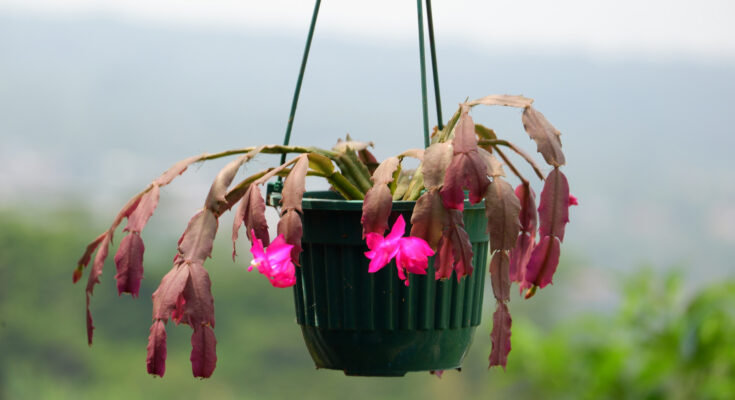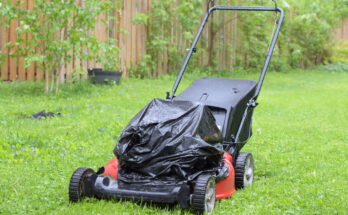9 Foolproof Ways To Bring Your Dying Christmas Cactus Back To Life
We may receive a commission on purchases made from links.
Good old Schlumbergera x buckleyi, better known as the Christmas cactus, is a fun plant to keep in your home. Not only is it considered pretty easy to grow, but those bright pink blooms pop up just as the winter blues begin to hit. That said, even the most loved cactus can take a turn for the worse if you’re not careful. Sometimes, it’s easy to deduce why a plant isn’t thriving. Maybe you went on vacation and it didn’t get watered for a couple of weeks, or you’ve been meaning to up-pot for awhile but just haven’t had a chance. Other times, the cause of the issue is less obvious.
Is your Christmas cactus looking lackluster, or worse, like it’s about to shrivel away and you’re not sure why? To help you remedy the issue we’ve collected the most foolproof ways to keep your cactus from teetering on the brink of death, either by updating one or two steps in your care routine, or by taking emergency measures — like drying out the soil or pruning off mushy roots. These methods aren’t intensive so don’t worry about getting overwhelmed; we’re confident that you’re up to the challenge. And if you want to see some satisfying proof of how well these tips can work, check out the videos we’ve included for a few that we found on social media showing the transformations you can trigger.
First, let’s talk care requirements for Christmas cacti
Before we get into all the handy hacks you can try for reviving a Christmas cactus that looks as if its days are numbered, here’s a brief breakdown of their general care requirements, so you can give your specimen ideal conditions after any resuscitation efforts, and spot where you may have been going wrong. First, a little context: Schlumbergera x buckleyi is a hybrid of S. russelliana and S. truncata, both of which are native to the mountains of Brazil and grow under the tree canopies, living on trees or rocks instead of in soil. Christmas cacti don’t have leaves; the green parts are actually stems called “phylloclades.”
The ideal care requirements for Christmas cacti are: spots that have high humidity, low drafts, and consistent temperatures between 70 to 80 degrees Fahrenheit during the day and 55 to 65 degrees Fahrenheit at night. Since these cacti are epiphytic, they need soil that’s incredibly well-draining so use a mix made for cacti or succulents. They also need pots that have excellent drainage. While they may not have “true” leaves, phylloclades are still responsible for photosynthesis and so need dusting regularly to remove debris that clog stomata – the holes plant foliage have to take in CO2. Water the plants sparingly, letting the soil dry out between waterings. Increase the water slightly in the spring and summer but reduce after it blooms. You can fertilize with a diluted, well-balanced fertilizer in late summer, and switch to a blend that’s higher in phosphorus and potassium but low in nitrogen during the fall, then stop during bloom season and for the rest of winter.
Adjust the light and temperature if your cactus isn’t blooming
If your Christmas cactus isn’t blooming, this doesn’t necessarily mean it’s dying. But, a lack of blooms can make many plant parents panic, and resort to drastic changes that only make things worse. So, let’s address why your Christmas cactus hasn’t bloomed and why its lighting or temp situation is most likely the culprit. First off, while a missed holiday bloom is not a sign that your plant is dying, it is often a warning signal that something is off in either its lighting or climate. Your points of triage should be to make sure the plant is in a spot that gets around 13 hours of total darkness a day during the winter and that the temperature stays consistently between 55 degrees and 80 degrees Fahrenheit.
If your Christmas cactus isn’t showing any buds after mid-November, check for drafts and potential light sources. Even things like lamps in an adjacent hallway or room could affect it so try to put it somewhere sheltered from accidental light and keep it away from uninsulated, drafty windows. If that’s easier said than done, you can go the unglamorous, yet incredibly effective, route and just put a box over it at night and remove it during the day. Another option is to keep it outside until the very first frost date, provided it won’t receive artificial light exposure there. Blooms typically open a month or so after that in most areas — and so you might still need to protect the plant from artificial light indoors so that disruption to the light cycle doesn’t prevent bud set. After the buds have set, you don’t have to micro-manage the light cycle.
Keep your Christmas cactus in one spot; multiple relocations can make it sad
We know we’ve just suggested switching up locations if your cactus doesn’t bloom, but moving it multiple times can cause your plant stress that leads to a weakened state making it susceptible to dropped leaves, disease, and pests. Sudden changes do not make this plant happy, so, if your cactus begins to droop, loses stems or buds, or is just in a sorry-looking state, think back to the last time it was moved. If it’s relatively recently, like within the past few months, it could just be acclimating to its new home.
Your best way to get it to bounce back is to leave it put but keep an eye out for pests or bacterial infections, just in case. If moving it is an absolute necessity, try to do it when the cactus is blooming as this is its most resilient time. Moving during bud development, while sometimes unavoidable, can cause flower buds to drop.
Check the pot’s drainage and add more if necessary
Since Schlumbergera plants are naturally epiphytic they have little tolerance for moist soil. But since you probably don’t have a giant tree or boulder in your home it can live off of, we’ll need to make the best of it. If your Christmas cactus’s soil looks a little too moist and your plant begins to show signs of waterlogged stress like flat, droopy leaves, you’ll need to act fast as overwatering is one of the deadly mistakes that can kill Christmas cacti.
Remove your cactus from its pot and check for drainage holes and add a few more if you think there aren’t enough. Plastic pots are pretty each to punch through with a sharp object like a nail, but if you’re adding drainage holes to a ceramic planter then you’ll need a drill and a carbide drill bit (like this Bosch HEX-9 Hard Ceramic Drill Bit). Repot the cactus in a soil blend designed for succulents and cacti as these are tailored for plants that need extremely well-draining soil and mimics the desert-like conditions these tough plants need. It’s the best compromise you can make for a plant that naturally lives out of soil but needs something to live off of as a houseplant.
Prune off every mushy root
Let’s say you’ve waited too long to rescue your holiday cactus from a situation where the excess moisture isn’t draining and now you’re pretty sure root rot has set in? If that’s the case, you’ll need to act fast to save your Christmas cactus from root rot. Immediately pull it out of the soil and inspect the roots. If they look brown, mushy, or have a musty smell, those are the tell-tale signs of root rot and you’ve got to do a little surgery to save your cactus. First, sterilize your pruning shears with an alcohol wipe or isopropyl alcohol to prevent bacteria from infecting the wounds. Next, cut off every piece of rot you see, pushing it to the side so that it doesn’t get accidentally added back into the soil. You may need to be ruthless about this and cut off more than you’re comfortable with, but even a little bit of rot can come back with a vengeance.
After this, your cactus might be weak so you may want to trim back its stems, too, so that it has less foliage to support with its smaller root system. You might expect the next step to be putting it back in the soil, but leave the roots out for a day or so to air dry. Remember, these guys are succulents so they can tolerate drying out easier than they can overly-moist conditions. After a few days, repot your Christmas cactus in fresh, well-draining soil and place it somewhere that has the ideal conditions it needs, then keep an eye on it for the next few weeks. Keep watering to a minimum and try only supply water to the roots, without saturating the entire pot.
Cut off all the diseased and dead foliage, too
Like root rot, diseased or damaged stems can spread throughout the cactus if you’re not vigilant. Schlumbergera are fairly pest- and disease-resistant, so when you notice an outbreak you know your cactus is having a rough go of it. If your plant’s stems look discolored, are coated with a sticky substance, or you see small, brown bumps (which, upon closer inspection, turn out to be scale), then it’s time to get out the pruning shears. Sterilize them first to prevent bacteria from entering the wound and clip off any damaged stems, buds, or branches. Not only will this help remove whatever outbreak is happening, but it also means the plant needs to support fewer stems, letting it direct more effort towards the healthy foliage instead. This same logic can apply even if your plant isn’t struggling with a disease. By pruning back unhealthy-looking stems that have lost their vigor through neglect, adverse conditions, or old age, you can stimulate the plant to produce and direct energy to fresh, plump, new ones.
Keep in mind, though, that if it’s a pest outbreak then you may need to also treat the plant with an insecticide, especially if the outbreak is on more than a few stems. However, starting by cutting off the parts that look the saddest can help your plant bounce back stronger and healthier faster than you’d expect. Make sure to inspect any plants living nearby, too, to ensure they’re not harboring their own pest or disease outbreak. As for when and how to prune a Christmas cactus to keep it healthy and producing blooms, stick to pruning right after it flowers.
Give it fresh soil
If you’ve checked your cactus’s living conditions, roots, and stems, and found nothing wrong, then it could be that your plant is dying because of the soil. Christmas cacti can live for decades by pulling nutrients from the soil, but that nutrient cache has a finite limit. If it’s been a few years since you’ve repotted your cactus, it could be that its potting soil is tapped out and needs a refresh.
If your potting mix looks gray, yellow, or your cactus’s stems begin to turn yellow, generally pale, or reddish in color, then it’s probably low on nutrients. Use a fresh bag of soil designed for cactus or succulents, or make your own blend with soil, peat moss, perlite, and a balanced slow-release fertilizer. However, just because it’s time for a soil refresh doesn’t necessarily mean it’s also time for a pot upgrade, too. Christmas cacti prefer to be a little pot-bound and a pot that’s too big could potentially hold more water in the soil than it needs, resulting in root rot.
Repot but only if necessary
We all need the occasional space refresh, and Christmas cacti aren’t any different. However, their pickiness around changes means you’ll need to tread carefully and plan your repotting strategy accordingly. Repotting your Christmas cactus is a good thing if it becomes too big for its pot and pushes roots out of the drainage holes or if it’s been around four years since the last repot. You may notice it’s time for an upgrade when your cactus starts to look tired or droopy due to being confined in too-small of a pot.
As we said before, Christmas cacti prefer to be a smidge pot-bound, so don’t upsize their quarters too much — just enough so that they can stretch out a little more. Remove the plant from its old pot and tease the root ball to loosen it up, but do this gently to reduce the likelihood of transfer shock after repotting. Once it’s ready to go, add some fresh soil to a new pot. The pot should also be deep enough that the root ball is around one inch below the rim. Your cactus spends a lot of energy and effort to bloom, so your best bet is to wait until it’s done flowering to repot; repotting during its growing seasons could stress the plant out, resulting in no blooms and making it prone to pests or disease.
If your Christmas cactus looks on the verge of death after blooming, feed it
Fertilizing is tricky because you need to pay attention to the natural growing cycle of your cactus and be sure not to overdo things. However, if your Christmas cactus looks absolutely like it’s exhausted its resources after blooming then give it a little hit of fertilizer. TPS Nutrients’ Christmas Cactus Fertilizer is specifically designed to give Schlumbergera the nutrients it needs to bounce back — just remember to go lightly and only step up fertilizing frequency during the spring and summer when your Christmas cactus is ready to start pushing out new phylloclades.
But what’s the difference between a normal end-of-bloom cycle and one where the plant is hungry for nutrients and looks like it’s dyeing? Discoloration, wrinkles, or curling on the phylloclades closest to the spent flowers are the easiest tell-tale signs your cactus needs a little help. If you see brown phylloclades or black spots, this can be a sign of overwatering and not a lack of nutrients, so follow the steps for fixing an overwatering situation mentioned above.
Dry out an overly wet Christmas cactus that’s dropping leaves with a fan
If your Christmas cactus hasn’t gotten to the point of root rot, but still has a little too much moisture for your comfort — and you notice it’s dropping leaves and buds — consider drying it out with a small fan. Not only will this help speed up evaporation on waterlogged stems, but it can also shoo off the first pest scouts that might be eyeing up your cactus as potentially prime real estate. Small fans will probably work best as they’re gentle enough to not break the stems but really, any fan that’s not rated for industrial use should be fine. You can either opt to just dry out the surface of the soil by leaving the Christmas cactus in its container, or if waterlogging situation is dire, take the more drastic measure shown in this video. However, be aware that this will probably work best on small, newly-bought specimens where the soil and root ball will easily slide out of the nursery pot without falling apart.
Besides these emergency measures, here are some tips to ensure you don’t end up in the same situation again. When you water your Christmas cactus, aim for the soil and not the foliage — this ensures the roots get the crucial moisture they need and prevents water from sitting too long in places it shouldn’t. You can also try watering from the bottom by placing your plant in a tray or sink with a few inches of water. If you see mold or stems that look really soggy, it could be a sign that water is sitting on them for too long and causing rot or fungal issues. Pay very close attention to any mold and take drastic action the instant you see it. Greyish-whitish mold could be Botrytis blight, a fungi that feeds on vegetation. Unfortunately, a blight outbreak means taking nuclear-level measures and destroying the plant to prevent the blight from spreading to the rest of your collection, so control and contain it as quickly as possible.



